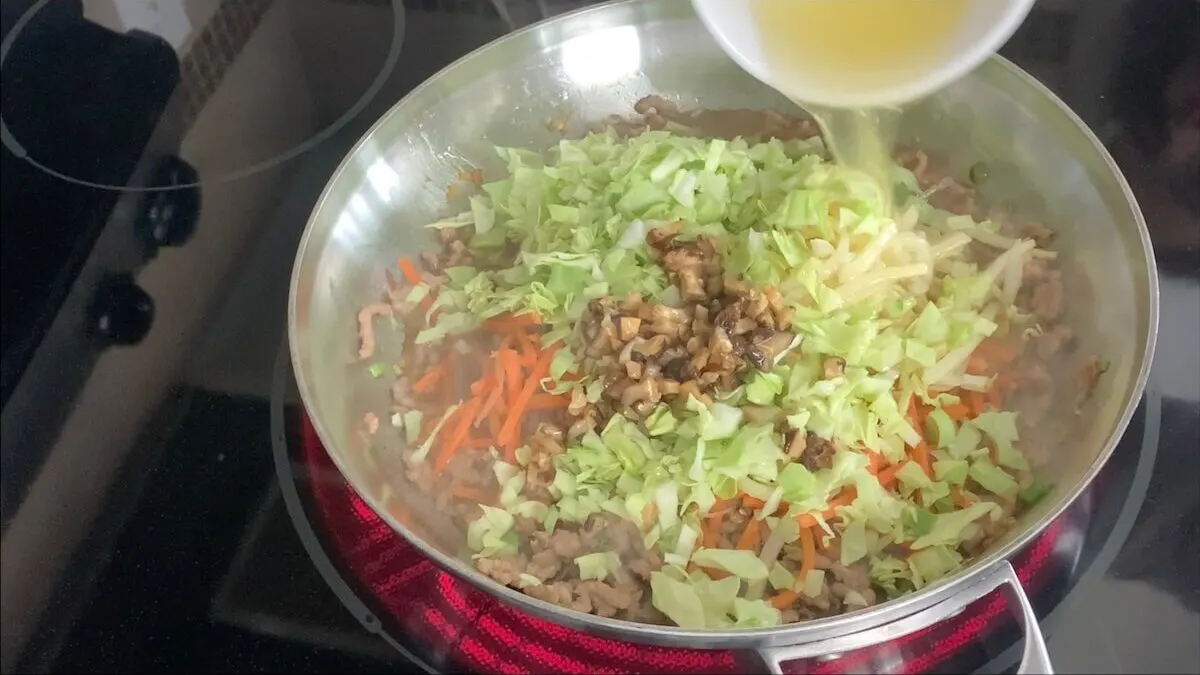
The perfect starter to any Japanese meal, harumaki (or Japanese spring rolls) are known for their savory pork and veggie fillings and crunchy outer shells. These Japanese spring rolls are always a hit whenever we have them at our house.

Table of Contents
What are Harumaki?

Harumaki is the Japanese version of spring rolls. Often very similar to their Chinese counterparts, harumaki often have a thinner shell and a more juicy filling. However, the ingredients used in their fillings vary widely depending on the person preparing it. I personally enjoy a pork filling with mushrooms, carrots, bamboo shoots, and cabbage as the main veggies. Many people use shrimp or chicken as the primary protein with a wide variety of veggies. Unlike spring rolls from countries such as Vietnam, harumaki are almost always fried in oil, giving them a crispy shell.
Harumaki are a versatile side and can be enjoyed as a appetizer in a meal or a snack at a party. Japanese spring rolls are commonly served with a wide variety of dipping sauces ranging from sweet to savory. Personally, I enjoy dipping harumaki in ponzu sauce as the citrus flavor of the ponzu goes great with the savory pork filling.
How to Make Harumaki?
While they are a few steps to preparing them, they go together pretty quick once you get going.
1. Before you begin, soak the shiitake mushrooms in a bowl of cold water for 20-30 minutes (or even overnight in the fridge if you have the time).
2. Prepare the vegetables for the filling by shredding the cabbage and carrots, dicing the shiitake mushrooms and green onions, and grating the ginger.
3. Add the pork, sesame oil, mirin, soy sauce, ginger, green onions, salt, and pepper to a large skillet and cook on medium-high heat until the pork is beginning to brown (about 3 minutes).

4. After 3 minutes of so, add shredded cabbage, carrots, shiitake mushrooms, bamboo shoots, and chicken stock to the pork mixture and cook for around five minutes (or until the vegetables are fully cooked).

5. Once the veggies are cooked, remove the mixture from heat and allow to cool to room temperature.
6. Heat the vegetable oil in a sauce pan on medium heat until the temperature is around 350 degrees.

7. Once the filling mixture is cool, evenly divide the filling into ten servings.
8. Place one serving of mixture in one corner of the spring roll wrapper. Starting with the corner that contains the filling, roll wrapper over the filling until you reach the halfway point.

9. Once you are halfway through wrapping the harumaki, wet the unrolled sides of the spring roll wrapper, fold in the two side corners, and continue wrapping the roll until it’s fully wrapped. While wrapping the last half of the roll, use your fingers to ensure you have a small air pocket to prevent the roll from popping when cooking.

10. Cook the harumaki in the oil for around 3 minutes, or until the wrappers are crunchy and light brown in color.

11. Serve and enjoy!
Harumaki Recipe

Harumaki (Japanese Spring Rolls)
Equipment
- 1 Pot
- 1 Skillet
- 1 Mixing bowl
Ingredients
- 10 Spring roll wrappers
- 1/2 lb. Ground pork
- 1 Cup Cabbage (3-4 leaves) Shredded
- 1 Green onion Diced
- 4 oz Bamboo shoots
- 2 Shiitake mushrooms
- 4 oz. Shredded carrots
- 1 Tbsp. Ginger minced
- 1/2 tsp. Salt
- 1/8 tsp. Pepper
- 1 Tbsp. Soy sauce
- 1 Tbsp. Mirin
- 1/2 Cup Chicken stock
- 2 Tbsp. Sesame oil
- Vegetable oil
Instructions
- Soak the shiitake mushrooms in a bowl of cold water for 20-30 minutes (or even overnight in the fridge if you have the time).
- Prepare the vegetables for the filling by shredding the cabbage and carrots, dicing the shiitake mushrooms and green onions, and grating the ginger.
- Add the pork, sesame oil, mirin, soy sauce, ginger, green onions, salt, and pepper to a large skillet and cook on medium-high heat until the pork is beginning to brown (about 3 minutes).
- After 3 minutes of so, add shredded cabbage, carrots, shiitake mushrooms, bamboo shoots, and chicken stock to the pork mixture and cook for around five minutes (or until the vegetables are fully cooked).
- Once the veggies are cooked, remove the mixture from heat and allow to cool to room temperature.
- Heat the vegetable oil in a sauce pan on medium heat until the temperature is around 350 degrees.
- Once the filling mixture is cool, evenly divide the filling into ten servings.
- Place one serving of mixture in one corner of the spring roll wrapper. Starting with the corner that contains the filling, roll wrapper over the filling until you reach the halfway point.

- Once you are halfway through wrapping the harumaki, wet the unrolled sides of the spring roll wrapper, fold in the two side corners, and continue wrapping the roll until it's fully wrapped. While wrapping the last half of the roll, use your fingers to ensure you have a small air pocket to prevent the roll from popping when cooking.

- Cook the harumaki in the oil for around 3 minutes, or until the wrappers are crunchy and light brown in color.
- Serve and enjoy!
Video
Nutrition
Frequently Asked Questions
Are Japanese spring rolls gluten-free?
Harumaki, or Japanese spring rolls, will almost always contain gluten unless it specifically states that it’s gluten-free. This is because the harumaki shells typically contain gluten. The fillings also usually contain soy sauce, which contains gluten.
How does harumaki (Japanese spring rolls) differ from egg rolls?
Harumaki is a Japanese version of the spring roll and has a thinner and more crispy shell whereas egg rolls are a Chinese-American version of spring rolls with a thicker and more bumpy shell. While the ingredients vary widely depending on the chef preparing the spring rolls or egg rolls, harumaki often has a more juicy filling than egg rolls.
Final Thoughts on Harumaki (Japanese Spring Rolls)
Japanese spring rolls are a savory treat that is definitely worth the effort to prepare. I hope that you have enjoy this recipe as much as my family does. Happy cooking!
For more great videos subscribe to our YouTube Channel.
Check out below for more great articles:
